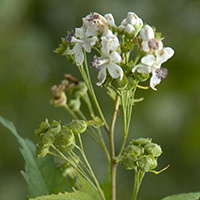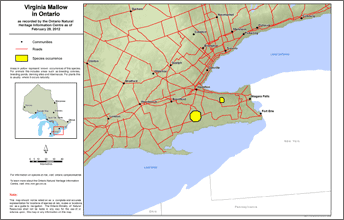Virginia mallow
Scientific name: Ripariosida hermaphrodita

Cover photo credit: Melinda Thompson-Black
Status
Endangered
Endangered
means the species lives in the wild in Ontario but is facing imminent extinction or extirpation.
Date added to the Species at Risk in Ontario list
The Virginia mallow was already assessed as endangered when the Endangered Species Act took effect in 2008.
Read the Assessment report
On January 26, 2022, the scientific name of this species was updated on the Species at Risk in Ontario list from Sida hermaphrodita to Ripariosida hermaphrodita to be consistent with recent taxonomic changes. This name change does not change the protections afforded to the species under the Endangered Species Act, 2007 (ESA) or the applicability of any policies, permits and agreements, guidance documents or best management practices that may have been published or issued by the Government of Ontario in respect of the species.
What it looks like
Virginia mallow is a perennial flowering herb that can reach one to three metres in height. The flowers are made up of five white petals (about 8 millimetres long) that grow in a clustered formation.
They bloom in late summer until the first frost in the fall, which may make the species valuable to apiculturists (beekeepers). The leaves resemble stretched maple leaves and grow in an alternate pattern along the hairy stem. The appearance of hairs along the stem diminishes with age.
Where it lives
Virginia mallow grows in riparian habitats that are flooded in most years. It benefits from this moist environment and is usually found in sunny or partly shaded areas with sandy soils.
Loose sandy or rocky soils of scoured riversides and floodplains, and disturbed areas along roadsides and railroad banks are its preferred habitats.
Where it’s been found in Ontario
Virginia mallow is found from the Appalachian Mountains to the Mississippi and Atlantic watersheds. In Ontario, it is found in only two sites, in Haldimand County, and the Niagara Region.
View a larger version of this map (PDF)
What threatens it
Habitat destruction is the leading cause of decline for Virginia mallow throughout its range.
In southwestern Ontario, the species is likely limited by site disturbance such as mowing and pipeline maintenance.
Invasive wetland species that substantially alter wetland habitats, such as Common reed and Purple loosestrife, are also threats to the species.
Action we are taking
Endangered Species and their general habitat are automatically protected.
Recovery strategy
A recovery strategy advises the ministry on ways to ensure healthy numbers of the species return to Ontario.
Read the executive summary (February 18, 2011)
Read the recovery strategy (February 18, 2011)
Government response statement
A government response statement outlines the actions the government intends to take or support to help recover the species.
Read the government response statement (November 18, 2011)
Five-Year Review of Progress
A five-year review reports on progress made toward protecting and recovering a species, within five years of publishing a species’ government response statement.
Read the report on progress towards the protection and recovery of 27 species at risk, including Virginia Mallow (2016).
Habitat protection
A habitat regulation defines a species' habitat and many describe features (for example, a creek, cliff, or beach), geographic boundaries or other unique characteristics.
Read the habitat summary (July 1, 2012)
What you can do
Report a sighting
Report a sighting of an endangered animal or plant to the Natural Heritage Information Centre. Photographs with specific locations or mapping coordinates are always helpful.
Volunteer
Volunteer with your local nature club or provincial park to participate in surveys or stewardship work focused on species at risk.
Be a good steward
- private land owners have a very important role to play in species recovery; if you find Virginia mallow on your land, you may be eligible for stewardship programs that support the protection and recovery of species at risk and their habitats
- invasive species seriously threaten many of Ontario’s species at risk; to learn what you can do to help reduce the threat of invasive species, visit:
- as with many other rare plants and animals, Virginia mallow is at risk due to habitat destruction; you can help by protecting any wetlands and surrounding natural vegetation on your property
- the Carolinian forests of southern Ontario support an amazing diversity of plants and wildlife, including many species at risk; Carolinian Canada is working to help recover species at risk and their habitats
Report illegal activity
Report any illegal activity related to species at risk to
Quick facts
- in Poland and Russia, Virginia mallow is cultivated and used as biomass for creating energy and heat
- Virginia mallow stems have unusually high concentrations of cellulose, resins and wax which could make it valuable to the paper industry if it was cultured
- research suggests that cultivated Virginia mallow may be useful in waste facilities as it can uptake cobalt, iron and nickel from the soil
- a large Virginia mallow plant can produce several thousand seeds
